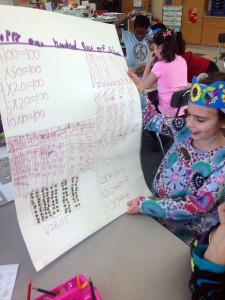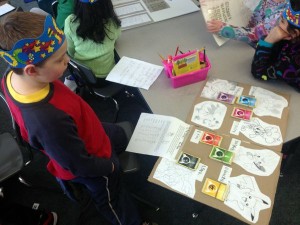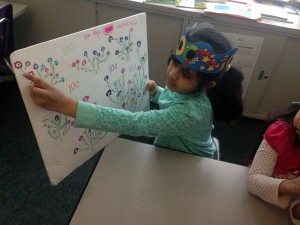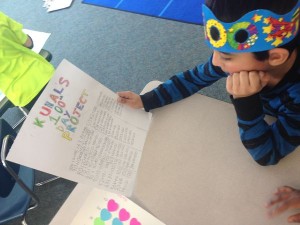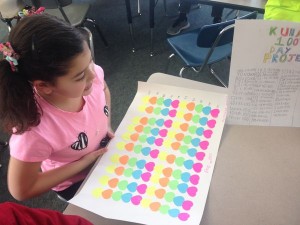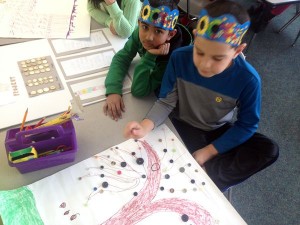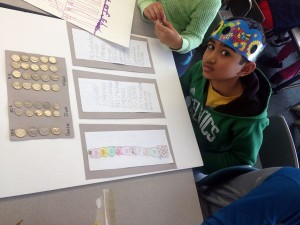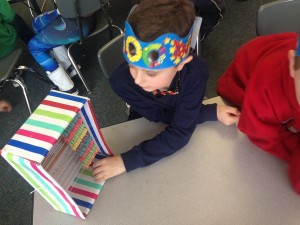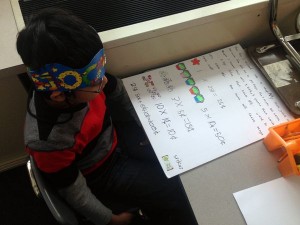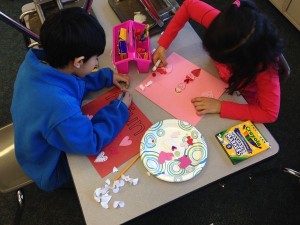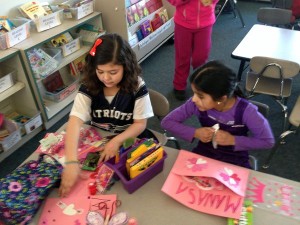Posted by kavery508 | Posted in Uncategorized | Posted on February 24, 2015
Despite the snow and indoor recess, we had a busy and fun week before vacation! The 100 Day posters that students created were impressive, creative, and filled with evidence of learning. Thanks for helping at home! Students acted as math experts, presenting the information in their projects to peers in ways that showed their understanding. Kudos to them!
We ended the week by celebrating our classroom community with valentines and kind words. Coming back fresh from vacation provides us with a good opportunity to re-focus our efforts on building and maintaining a supportive atmosphere by saying and doing expected things in the classroom and building. We will spend some time reviewing and practicing these in the weeks ahead.
 Our CAFE reading work focuses on the Comprehension strategy Determining Importance. When reading text, especially informative text, there is a Main Idea and supporting details. Learning to recognize interesting details and differentiate them from important information is key to good understanding. Think about how we read a magazine article as adults. We look at the title and headings, and as we read we are always thinking about how the information relates to the topic. This helps us to disregard unimportant facts so we can retain essential ideas. To try this with your child at home, go to http://www.timeforkids.com/news. Choose an article to read together. After each section, talk about the interesting ideas and then decide on one main idea for each (often the headings are big clues). What information was important, and what was merely interesting?
Our CAFE reading work focuses on the Comprehension strategy Determining Importance. When reading text, especially informative text, there is a Main Idea and supporting details. Learning to recognize interesting details and differentiate them from important information is key to good understanding. Think about how we read a magazine article as adults. We look at the title and headings, and as we read we are always thinking about how the information relates to the topic. This helps us to disregard unimportant facts so we can retain essential ideas. To try this with your child at home, go to http://www.timeforkids.com/news. Choose an article to read together. After each section, talk about the interesting ideas and then decide on one main idea for each (often the headings are big clues). What information was important, and what was merely interesting?
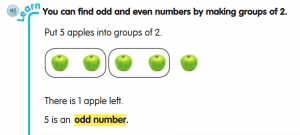 Having learned strategies for multiplying 2s and 5s (skip counting; finger counting; dot paper), we now apply them to multiplying 10s. In addition, we will review the commutative property (e.g. 10 x 2 = 2 x 10) while stressing the need to model these correctly when solving problems. We will then learn to use multiplication of 2s (repeated addition of groups of 2) to learn odd and even numbers. Students will be taught to group objects by 2s and if there is none left over then it is even; otherwise it is odd. Learning it this way helps students to understand the nature of odd and even as opposed to only applying tricks (e.g. it’s even if it ends with 0, 2, 4, etc.).
Having learned strategies for multiplying 2s and 5s (skip counting; finger counting; dot paper), we now apply them to multiplying 10s. In addition, we will review the commutative property (e.g. 10 x 2 = 2 x 10) while stressing the need to model these correctly when solving problems. We will then learn to use multiplication of 2s (repeated addition of groups of 2) to learn odd and even numbers. Students will be taught to group objects by 2s and if there is none left over then it is even; otherwise it is odd. Learning it this way helps students to understand the nature of odd and even as opposed to only applying tricks (e.g. it’s even if it ends with 0, 2, 4, etc.).
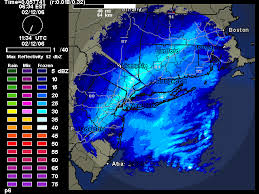 Our social studies map work continues with an introduction to natural features (oceans, landforms, atmosphere, plants, and animals) and cultural features (anything made by people, including farms and borders). A great way to see many of these at once is to watch local weather forecasts. The maps used show borders of states, towns, counties, landforms, water sources, air flow, etc. See how many you can find!
Our social studies map work continues with an introduction to natural features (oceans, landforms, atmosphere, plants, and animals) and cultural features (anything made by people, including farms and borders). A great way to see many of these at once is to watch local weather forecasts. The maps used show borders of states, towns, counties, landforms, water sources, air flow, etc. See how many you can find!
 We have become experts at observing and identifying weather, clouds, and temperature these past two months to help us answer the question, How does weather change day to day and over time? As part of data collection and analysis, students will be evaluating graphs (pie chart, bar graph, area graph) to select the best format for presenting their data collected on daily temperature. They will then enter data and create their graphs using online software at http://nces.ed.gov/nceskids/createagraph/. Finally, they will analyze the data using graphs to look for trends and anomalies, and to draw conclusions. Try the graphing software yourself using any data from home (homework minutes each night; minutes spent getting ready for bed; etc.). The results are really cool!
We have become experts at observing and identifying weather, clouds, and temperature these past two months to help us answer the question, How does weather change day to day and over time? As part of data collection and analysis, students will be evaluating graphs (pie chart, bar graph, area graph) to select the best format for presenting their data collected on daily temperature. They will then enter data and create their graphs using online software at http://nces.ed.gov/nceskids/createagraph/. Finally, they will analyze the data using graphs to look for trends and anomalies, and to draw conclusions. Try the graphing software yourself using any data from home (homework minutes each night; minutes spent getting ready for bed; etc.). The results are really cool!

